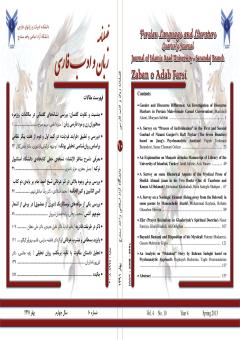رمزگشایی داستان قلعۀ ذات الصُوَر مثنوی معنوی
محورهای موضوعی : زبان و ادب فارسی
1 - هیأت علمی گروه زبان و ادبیات فارسی، واحد سنندج، دانشگاه آزاد اسلامی، سنندج، ایران
کلید واژه: مثنوی, نماد, دژ هوش ربا,
چکیده مقاله :
استفاده از تمثیل و حکایات در ادبیات ملل یکی از راههای انتقال مفاهیم است که تأثیر و ماندگاری آن نسبت به دیگر گونههای ادای کلام، به مراتب بر مخاطب بیشتر است. بهره بردن از تمثیل چنان مهم است که بخش اعظم آیات قرآن تمثیل است و خداوند بزرگ از این گونۀ بیانی برای ارائۀ مطالب عمیق تربیتی استفاده کرده است. تمثیل در متون ادب فارسی نیز سابقۀ دیرینهای دارد. به ویژه در میان واعظان و مجلس گویان و عارفان یکی از ابزار انتقال مفاهیم پرورشی است. مولانا جلال الدین به تبع از مجلس گویان و واعظان و برای تأثیرگذاری بیشتر از حکایات و تمثیل به وفور استفاده کرده است تا آنجا که مثنوی معنوی او سراسر مجموعهای از حکایات گاه تو در تو است که به خوبی توانسته است از آنها بهره ببرد. یکی از این حکایتها، حکایت قلعۀ ذات الصور است که از غرر تمثیلات مثنوی است و پایان این کتاب جلیل را به آغازش وصل کرده است. نویسنده در این مقاله از این حکایت رمزگشایی کرده و به این پرسش پاسخ میدهد که آیا داستان دژ هوش ربا به پایان رسیده است یا خیر؟ پژوهش به روش توصیفی – تحلیلی با استفاده از منابع کتابخانهای نوشته شده و نتایج حاکی از آن است که حکایت کاهل در پایان مثنوی در واقع تتمۀ حکایت دژ هوش ربا است.
The use of allegory and anecdotes in the literature of nations is one of the ways of conveying concepts, the impact and durability of which is far greater on the audience than other types of speech. It is so important to take advantage of allegory that most of the verses of the Quran are allegory and the great God has used this kind of expression to present deep educational content. Allegory in Persian literary texts also has a long history. It is one of the means of conveying educational concepts, especially among the preachers and Majlis Goyans and mystics. Maulana Jalaluddin has used anecdotes and similes in order to have more impact, so much so that his spiritual masnavi is a collection of occasional anecdotes that he has been able to make good use of. One of these stories is the story of the castle of Zat al-Soor, which is part of the parables of Masnavi, and Jalil has connected the end of this book to its beginning. In this article, the author decodes this story and answers the question whether the story of Dej Hosh Raba is over or not. The research was written in a descriptive-analytical method using library sources and the results indicate that the story of Kahl at the end of the Masnavi is actually the continuation of the story of Dej Hosh Raba.
قرآن کريم.
استعلامي، محمد(1372)، مثنوي، مقدمه، تصحيح، تعليقات و فهرست. تهران: زوار.
انقروي، رسوخ الدين اسماعيل (1375). شرح کبير انقروي بر مثنوي مولوي، ترجمه عصمت ستارزاده، تهران: انتشارات زرين.
پورنامداريان، تقي (1375). رمز و داستانهاي رمزي در ادب فارسي، تهران: انتشارات علمي و فرهنگي.
خلف الله، محمد احمد (1402). هنر داستاني در قرآن کريم، ترجمۀ محسن آرمين. تهران: نشر ني.
راغب اصفهاني، حسين بن محمد (1389). المفردات في غريب القرآن. ترجمه: جهانگير ولدبيگي، تهران: احسان.
زرين کوب، عبدالحسين (1374). بحر در کوزه (نقد و تفسير قصه¬ها و تمثيلات مثنوي)، تهران: انتشارات علمي.
زماني، کريم (1379)، شرح جامع مثنوي معنوي، تهران: اطلاعات.
سياح¬زادف، مهدي (1402). پيمانه و دانه (شرح و تفسير همۀ داستانهاي مثنوي معنوي به نثر روان امروزي)، تهران: انتشارات مهرانديش.
فتوحي رود معجني، محمود (1384) مقالۀ تمثيل، ماهيت، اقسام، کارکرد، مندرج در نشريۀ ادبيات و علوم انساني دانشگاه خوارزمي، دوره 12، 13، شمارۀ 47-49، صص 141- 178.
فروزانفر، بديع¬الزمان، (1370)، مآخذ قَصَص و تمثيلات مثنوي، تهران:اميرکبير.
ميرصادقي، ميمنت (1373). واژه¬نامۀ هنر شاعري. تهران: کتاب مهناز.
ميرصادقي، ميمنت و جمال ميرصادقي ( 1388). واژه¬نامۀ هنر داستان نويسي. تهران: گتاب مهناز.
همايي، جلال الدين (1373). تفسير مثنوي مولوي، تهران: نشر هما.
Resources
Holy Quran
Istilami, Mohammad (1372), Masnavi, introduction, correction, comments and list. Tehran: Zovar.
Ankaravi, Reshmouddin Ismail (1375). Kabir Ankaravi's Commentary on Mawlawi's Masnavi, translated by Esmat Sattarzadeh, Tehran: Zarin Publications.
Pournamdarian, Taghi (1375). Code and secret stories in Persian literature, Tehran: Scientific and Cultural Publications.
Khalafullah, Muhammad Ahmad (1402). Narrative art in the Holy Quran, translated by Mohsen Armin. Tehran: No publication.
Ragheb Esfahani, Hussein bin Mohammad (1389). Al-Mufardat in Gharib al-Qur'an. Translation: Jahangir Voldbighi, Tehran: Ehsan.
Zarin Koob, Abdul Hossein (1374). The sea in the jar (criticism and interpretation of Masnavi stories and parables), Tehran: Scientific Publications.
Zamani, Karim (1379), the comprehensive description of Masnavi al-Manivi, Tehran: Information.
Syahzadov, Mehdi (1402). Paymaneh and Daneh (explanation and interpretation of all spiritual Masnavi stories in modern fluent prose), Tehran: Mehrandish Publications.
Fatuhi Roud Mojni, Mahmoud (2004) The article on allegory, nature, types, function, included in the literature and human sciences journal of Khwarazmi University, period 12, 13, number 47-49, pp. 141-178.
Forozanfar, Badi-ul-Zaman, (1370), sources of stories and parables of Masnavi, Tehran: Amir Kabir.
Mirsadeghi, Mayment (1373). Dictionary of poetic art. Tehran: Mahnaz Kitab.
Mirsadeghi, Mayment and Jamal Mirsadeghi (1388). Dictionary of the art of story writing. Tehran: Getab Mahnaz.
Homayi, Jalaluddin (1373). Tafsir Masnavi Molavi, Tehran: Homa Publishing.


